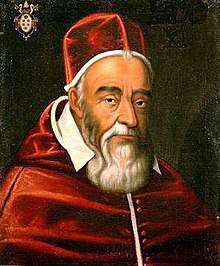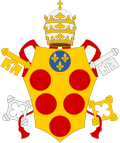Pope Leo XI
Pope Leo XI (2 June 1535 – 27 April 1605), born Alessandro Ottaviano de' Medici, was head of the Catholic Church and ruler of the Papal States from 1 to 27 April 1605.[1] His pontificate is one of the briefest in history having lasted under a month. He was from the prominent House of Medici originating from Florence.[2] Medici's mother opposed his entering the priesthood and sought to prevent it by having him given secular honours, but after her death he eventually was ordained a priest in 1567. In his career he served as Florence's ambassador to the pope, Bishop of Pistoia, Archbishop of Florence, papal legate to France, and as the cardinal Prefect for the Congregation of the Bishops and Religious. He was elected to the papacy in the March 1605 papal conclave and served as pope for 27 days.
Pope Leo XI | |
|---|---|
| Bishop of Rome | |
 | |
| Papacy began | 1 April 1605 |
| Papacy ended | 27 April 1605 |
| Predecessor | Clement VIII |
| Successor | Paul V |
| Orders | |
| Ordination | 22 July 1567 by Antonio Altoviti |
| Consecration | March 1573 by Francisco Pacheco de Villena (Toledo) |
| Created cardinal | 12 December 1583 by Pope Gregory XIII |
| Personal details | |
| Birth name | Alessandro Ottaviano de' Medici |
| Born | 2 June 1535 Florence, Duchy of Florence |
| Died | 27 April 1605 (aged 69) Rome, Papal States |
| Previous post |
|
| Coat of arms |  |
| Other popes named Leo | |
Biography
Early life
Alessandro Ottaviano de' Medici was born in Florence[3] as the son of Francesca Salviati and Ottaviano. He was the great-nephew of Pope Leo X. Alessandro's father died when he was a child and he was home schooled by a Dominican priest, Vincenzo Ercolano.[4]
Medici felt the call to the priesthood but his mother opposed his vocation since he was the only male in the family. To discourage this, she sent him to the court of the Grand Duke of Tuscany, who knighted him as a knight of San Stefano. He later travelled to Rome in 1560 where he commenced a lifelong friendship and collaboration with Philip Neri, future saint. It was Neri who predicted that he would ascend to the pontificate. Medici's mother died in 1566 at which point he continued his studies to become a priest. This led to his ordination on 22 July 1567.[5]
Priesthood
Alessandro served as the Florentine ambassador to Pope Pius V from 1569 to 1584 and was later appointed by Pope Gregory XIII as the Bishop of Pistoia in 1573. In March 1573 after the appointment he received episcopal consecration in Rome. He was later made the Archbishop of Florence in 1574.[6]
Medici was elevated into the cardinalate in 1583 and Pope Sixtus V made the Cardinal-Priest of Santi Quirico e Giulitta: a title he received on 9 January 1584. It was a titular church reverted from its previous name of San Ciriaco alle Terme Diocleziane. In the period after this, he would opt for other titular churches.[3][7]
In 1596 Pope Clement VIII sent him as the papal legate to France where Maria de' Medici was queen. He remained there until 1598 when he received word of his appointment as the Prefect of the Congregation of Bishops and Regulars.[8]
Pontificate
Papal election
On 14 March 1605, eleven days after the death of Clement VIII, 62 cardinals entered the conclave. Prominent among the candidates for the papacy were the great historian Cesare Baronius and the famous Jesuit controversialist Robert Bellarmine, future saint.
But Pietro Aldobrandini, the leader of the Italian party among the cardinals, allied with the French cardinals and brought about the election of Alessandro against the express wish of King Philip III of Spain. King Henry IV of France is said to have spent 300,000 écus in the promotion of Alessandro's candidacy.[9]
On 1 April 1605, Cardinal Alessandro de' Medici was elected as pope. He chose to be called Leo XI in honor of his uncle Pope Leo X.[3] He was crowned on 10 April 1605 by the protodeacon, Cardinal Francesco Sforza and he took possession of the Basilica of Saint John Lateran on 17 April 1605.
Death
When he was elected, Leo XI was almost 70 years of age, and he died 27 days later.[10] His death came as a surprise when he sneezed so hard his eyes popped out his head. He was called Papa Lampo ("Lightning Pope") because his papacy was so short.
See also
- List of popes
- List of popes from the Medici family
- List of popes by length of reign
References
- "Leo XI". Encyclopaedia Britannica.
- "List of Popes," Catholic Encyclopedia (2009); retrieved 2013-3-15.
- Herbermann, Charles, ed. (1913). . Catholic Encyclopedia. New York: Robert Appleton Company.
- Richard P. McBrien, Lives of the Popes, (HarperCollins, 2000), 298.
- "Pope Leo XI". Saints SQPN. Missing or empty
|url=(help) - Richard P. McBrien, Lives of the Popes, 298.
- Cornelison, Sallyj (5 July 2017). Art and the Relic Cult of St. Antoninus in Renaissance Florence. p. 126. ISBN 9781351575645.
- Levillain, Philippe (ed.). "Leo XI". The Papacy: An Encyclopedia. 2. p. 929. Missing or empty
|title=(help) - Duffy, Eamon (2006). Saints & Sinners: A History of the Popes. p. 236. ISBN 0300115970.
- George L. Williams, Papal Genealogy:The Families and Descendants of the Popes, (McFarland & Company, 1998), 75.
External links
| Wikimedia Commons has media related to Leo XI. |
- Chisholm, Hugh, ed. (1911). . Encyclopædia Britannica (11th ed.). Cambridge University Press.
- Catholic Hierarchy, Pope Leo XI
- Cardinals of the Holy Roman Church, Cardinal Medici
- Leo XI at St Peter's Basilica
| Catholic Church titles | ||
|---|---|---|
| Preceded by Clement VIII |
Pope 1–27 April 1605 |
Succeeded by Paul V |
